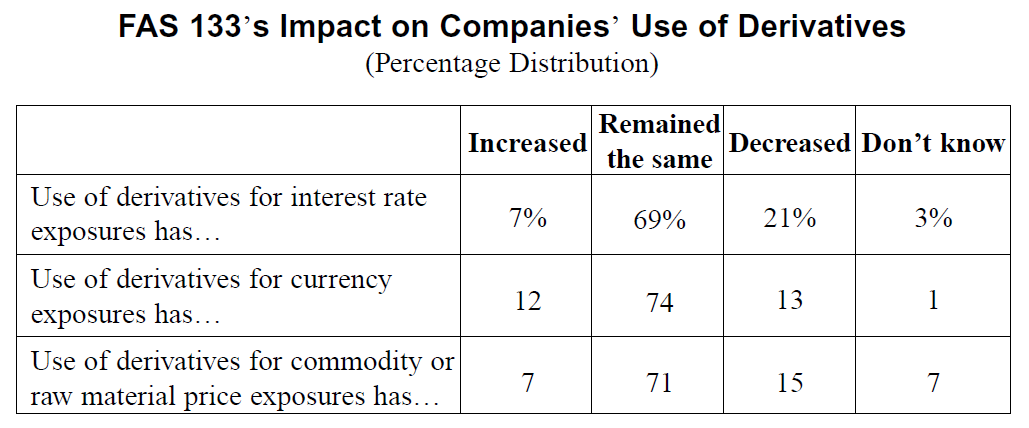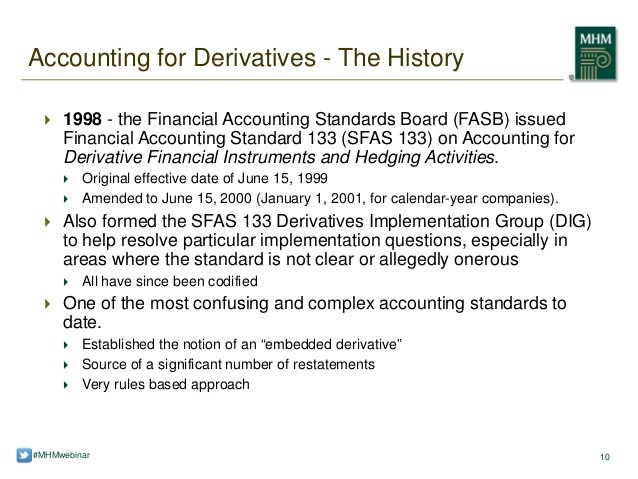Accounting for Derivatives FAS 133
Post on: 6 Сентябрь, 2015 No Comment

FAS 133
(Financial Accounting Standards Board Statement No. 133, Accounting for Derivative Instruments and Hedging Activities )
This Statement establishes accounting and reporting standards for derivative instruments, including certain derivative instruments embedded in other contracts, (collectively referred to as derivatives) and for hedging activities. It requires that an entity recognize all derivatives as either assets or liabilities in the statement of financial position and measure those instruments at fair value. If certain conditions are met, a derivative may be specifically designated as (a) a hedge of the exposure to changes in the fair value of a recognized asset or liability or an unrecognized firm commitment, (b) a hedge of the exposure to variable cash flows of a forecasted transaction, or (c) a hedge of the foreign currency exposure of a net investment in a foreign operation, an unrecognized firm commitment, an available-for-sale security, or a foreign-currency-denominated forecasted transaction.
The accounting for changes in the fair value of a derivative (that is, gains and losses) depends on the intended use of the derivative and the resulting designation.
- For a derivative designated as hedging the exposure to changes in the fair value of a recognized asset or liability or a firm commitment (referred to as a fair value hedge), the gain or loss is recognized in earnings in the period of change together with the offsetting loss or gain on the hedged item attributable to the risk being hedged. The effect of that accounting is to reflect in earnings the extent to which the hedge is not effective in achieving offsetting changes in fair value.
Under this Statement, an entity that elects to apply hedge accounting is required to establish at the inception of the hedge the method it will use for assessing the effectiveness of the hedging derivative and the measurement approach for determining the ineffective aspect of the hedge. Those methods must be consistent with the entity�s approach to managing risk.
This Statement applies to all entities. A not-for-profit organization should recognize the change in fair value of all derivatives as a change in net assets in the period of change. In a fair value hedge, the changes in the fair value of the hedged item attributable to the risk being hedged also are recognized. However, because of the format of their statement of financial performance, not-for-profit organizations are not permitted special hedge accounting for derivatives used to hedge forecasted transactions. This Statement does not address how a not-for-profit organization should determine the components of an operating measure if one is presented.
This Statement precludes designating a nonderivative financial instrument as a hedge of an asset, liability, unrecognized firm commitment, or forecasted transaction except that a nonderivative instrument denominated in a foreign currency may be designated as a hedge of the foreign currency exposure of an unrecognized firm commitment denominated in a foreign currency or a net investment in a foreign operation.
This Statement amends FASB Statement No. 52, Foreign Currency Translation, to permit special accounting for a hedge of a foreign currency forecasted transaction with a derivative. It supersedes FASB Statements No. 80, Accounting for Futures Contracts, No. 105, Disclosure of Information about Financial Instruments with Off-Balance-Sheet Risk and Financial Instruments with Concentrations of Credit Risk, and No. 119, Disclosure about Derivative Financial Instruments and Fair Value of Financial Instruments. It amends FASB Statement No. 107, Disclosures about Fair Value of Financial Instruments, to include in Statement 107 the disclosure provisions about concentrations of credit risk from Statement 105. This Statement also nullifies or modifies the consensuses reached in a number of issues addressed by the Emerging Issues Task Force.
A Critical View (from FAS133.com)
What is FAS 133?
Statement 133 (FAS 133 or SFAS 133) establishes accounting and reporting standards for derivative instruments, including certain derivative instruments embedded in other contracts and for hedging activities. Released in June 1998, FAS 133 represents the culmination of the US Financial Accounting Standards Board’s nearly decade-long effort to develop a comprehensive framework for derivatives and hedge accounting. The Financial Accounting Standards Board establishes generally accepted accounting principles for most companies operating in the United States or requiring financial statements meeting US GAAP (see FASB site for more).
Simplicity is not one of FAS 133�s strong suits. That�s partly because FAS 133 is a halfway house of sorts, falling short of full fair value accounting (the FASB�s ultimate goal) and maintaining some �old� accounting that dates back to FAS 52. This complexity is largely the reason the FASB has set up a special committee to deliberate and explain how to apply FAS 133. This committee is known as the Derivatives Implementation Group (DIG). Despite the special efforts of the DIG, the FASB was forced to delay implementation for one year. And now, working with the DIG, the FASB is considering amendments that change significantly the impact on certain accounting aspects.
A careful reading of the Statement, put within the context of its �founding fathers�� original intent, helps us collapse the lengthy document into key concepts:
(1) FAS 133 focuses on the hedge tools and not the sort of risk that�s being hedged .This is a fundamental change in hedge accounting. Instead of focusing on currency (FAS 52) or commodities (FAS 80), FAS 133 occupies itself with derivatives, no matter how they are used. The good news? If it�s not a derivative, it�s not scoped in. The bad news? The definition of a derivative is pretty wide and include several commercial contracts as well.
(2) FAS 133 is a compromise on fair value accounting. FAS 133 puts an end to deferral accounting as we know it. Ultimately, the Board would like to have all financial instruments on the balance sheet at fair value. Such a radical overhaul� particularly for non-banks�would have created massive income statement effects. So instead, the Board compromised, offering hedgers (vs. traders of derivatives) a halfway house in the form of Other Comprehensive Income (OCI). OCI is a place to �park� gains and losses on hedges until it is time to recognized them in current income. It�s part of the income statement, but not current earnings. This compromise solution, inevitably, creates inconsistency in the treatment of certain gains and losses.
(3) Volatility, volatility, volatility. Finally, much of the controversy surrounding FAS 133 has to do with the possibility that it will greatly increase income-statement volatility. Under the previous guidance, companies could �hide� ineffective, imprecise and simply bad hedges in the CTA account�deferring the effects on their P/(L). FAS 133 exposes such hedges by forcing companies to deliberately measure and record (in income) all ineffectiveness; plus, it basically outlaws some common hedge practices such as marco and portfolio hedging, netting and synthetic accounting in its various incarnation. The result is a much greater chance that hedge mismatch will create volatile earnings� sometimes for �good� reasons, and often for technical reasons that do not necessarily reflect the economics of the hedging relationship.
For example, time value in options must be marked to market in income in most cases, so even if the option hedge is perfectly effective at limiting the company�s downside risk with respect to future cash flows, the cost of the hedge (which used to be amortized in a straight line fashion) can become a source of undue volatility.
This worrisome potential of earning volatility is the �trigger� of various FAS 133-related trends. First, it will (and should) capture senior management attention. CFOs and CEOs don�t like earnings surprises, and neither does Wall Street. Second, bankers and risk management advisers are busy devising ways to limit the volatility of hedges by either changing strategies or inventing new hedge products. Hence much of the focus at the DIG level during 1999 on expanding the shortcut method (which basically allows hedgers to assume effectiveness, as long as the hedge and hedged item live up to a set of pretty strict criteria).
The three hedge relationships. Under FAS 133 (in order to qualify for hedge accounting) treasuries can define the relationship between a derivative and an exposure in one of three basic ways:

� Fair value hedges�Hedges of exposures to the changes in value of a recognized asset or liability, or unrecognized firm commitment.
� Cash flow hedges�Hedges of forecasted transactions, or the variability in the cash flow of a recognized asset or liability.
� Net investment hedges�Hedges of the net investment in a foreign operation.
While the accounting for these hedge relationships may vary, generally speaking:
� Fair value hedges�The derivatives are marked to market in earnings. The value of the hedge will be offset by changes in the value of the underlying exposure.
� Cash flow hedges�The derivatives are marked to market and carried at fair value. The effective portion is recorded in OCI. The ineffective portion goes into current income.
� Net investment hedges�The gain/losses in the hedge are recorded in OCI. Net investment hedges are only currency related and are a FAS 52 relic. Consequently, these hedges are inconsistent with much of the new derivatives accounting rule. For example, they allow treasury to hedge the �net� exposure. They also allow companies to use nonderivatives (e.g. foreign currency borrowing) to cover their investment risk.
What�s a Derivative Anyway? While FAS 133 is aimed primarily at derivatives, it defines derivatives rather broadly, so it can affect the accounting for many transactions that some financial statement preparers would never think of as derivatives. Identifying these derivatives, including those embedded in non-derivative contracts is a difficult aspect of implementing proper accounting under FAS 133.
Under the FAS 133 definition (paragraph 9)-
�A derivative instrument is a financial instrument or other contract with all three of the following characteristics:
(a) It has (1) one or more underlyings and (2) one or more notional amounts (by any other name) or payment provisions or both. Those terms determine the amount of the settlement or settlements, and, in some cases, whether or not a settlement is required.
(b) It requires no initial net investment or an initial net investment that is smaller than would be required for other types of contracts that would be expected to have a similar response to changes in market factors.
(c) Its terms require or permit net settlement, it can readily be settled net by a means outside the contract, or it provides for delivery of an asset that puts the recipient in a position not substantially different from net settlement.�
Thus FAS 133 alters the risk management agenda by changing the performance yardsticks for many treasuries.
Prof. Ian Giddy, New York University














